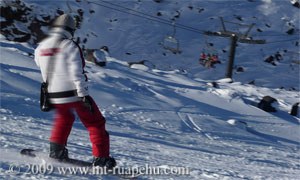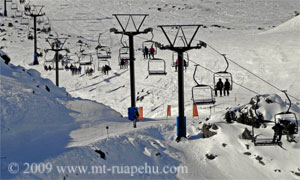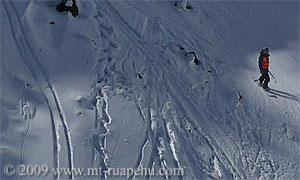Ruapehu Skiing History

Skiing on Turoa skifield on Mt Ruapehu
Skiing as a form of transport has been seen around New Zealand since the 1860s. Although for the first 50 years of its existence here it was exclusively in the domain of Norwegian gold miners in the South Island. It was not until 1913 that two men, frustrated with the cumbersome nature of walking through deep snow, attained skis and a book on the emerging sport of skiing, and introduced them to the Mount Ruapehu environment.
The two men, William Perret Mead and Bernard Drake, were the key force behind the introduction of skiing to Mount Ruapehu. They were aided by the fact that by 1887 the mountain tops of Ruapehu were gifted to the Crown by the paramount chief of Ngati Tuwharetoa Te Heuheu Tukino IV. These were turned into National Parks for their safety and protection. The mountain itself was by now attracting numerous tourists, and with the new park title warranted the building of dessert road which allowed for easier access to the mountain.

Skilift at Turoa skifield on Mt Ruapehu
From its humble start Mount Ruapehu saw a rapid rise as a destination for skiing. By 1920 huts had been built nearby the current location of the Chateau Tongariro. Huts were also constructed on the Ohakune side of the mountain. The first ski and climbing equipment hire facilities opened charging a rate of £1 per day.
The popularity of skiing on Mount Ruapehu continued to swell. Accommodation became a significant problem, it was remedied by Rudolph Wrigley who in the January of 1929 began construction of the iconic Chateau, which can still be seen on the mountain. By the August of the same year the Chataeu was operating, albeit not in full capacity.
With he evolution of skiing internationally and on Mt Ruapehu, up to date facilities soon came to be demanded. The rope tow, a predecessor to today’s lift facilities, was fitted on the lower slopes of Ruapehu on the Whakapapa side near the Salt Hut. Unfortunately, it broke down within hours of initial operation and it was never repaired.

Skiing on Turoa skifield on Mt Ruapehu
World War II saw an understandable lull in building for Ruapehu Skiing facilities. Yet, the end of the war saw a boom in interest higher than witnessed before. By 1949 at least one hut was being built a year, and membership to skiing clubs had grown into the thousands. Ski instruction was growing to the international level. The Whakapapa Rock Graden chairlift was built in 1959. The mid 60’s saw skier numbers increase into the 170,000s. Chairlifts were being rapidly built. The surge in popularity necessitated the building of the Turoa ski field in 1978. By then the facilities were relatively close to today’s level.





